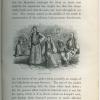Drawing of Bosnian people
Drawing in pencil by Arthur Evans of a group of people, identified as a depiction of various types attending an annual fair at the hillside shrine near Komušina, Bosnia and Herzegovina.
Artist: Arthur John Evans
Date of drawing: August 1875
Continent: Europe
Geographical area: Southern Europe
Country: Bosnia and Herzegovina
Region/Place: Komušina
Cultural group: European Bosnian
Format: Drawing
Size: 82 x 137 mm
Acquisition: Joan Evans. Donated August 1941
***
Exhibition caption: ‘One of a selection of drawings and ink sketches made by Arthur Evans while travelling with his brother through Bosnia and Herzegovina in the summer of 1875. They show people and places encountered by the pair on a route south from Agram (modern-day Zagreb) – via Tešanj, Sarajevo and Mostar – to Ragusa (Dubrovnik), which Evans and his wife were later to make their home. The illustrations demonstrate a particular interest in identity and dress, Evans writing, for example, of finding “two Bulgarians hard at work tying up bundles of onions, clad in their dark national costume – the brown tight-sleeved jacket embroidered with black, the dull red sash, the brown trowser-leggings which are equally Turkish and Tartar and on their head the black sheepskin cap which had at first attracted my attention.” As well as being an aide-mémoire, the drawings provided the basis for engravings published in Evans’ account of his journey, Through Bosnia and the Herzegóvina on Foot during the Insurrection, August and September 1875 (London, 1876). As an eyewitness account of a distant region in turmoil, the book was an immediate success, quoted extensively in Parliament, and it went into a second edition the following year.’ Source: ‘Travels in Finland and Bosnia-Herzegovina: An Ethnographic Collection of Sir Arthur Evans’, exhibition curated by Philip Grover, Pitt Rivers Museum, University of Oxford, 29 April to 1 September 2013.
Primary documentation: ‘[p.588] Dr. JOAN EVANS, from the property of the late SIR ARTHUR EVANS, Youlbury, Boars Hill, Oxford. [List of items follows]’; ‘[p.590] 21 Original pencil sketches, types & scenery. BALKANS’: Pitt Rivers Museum accession records (Donations X, 1937–1941), pp.588, 590. Annotations on drawing: ‘Group of Christian Peasants/ At the fair on mountain near Comusina [Komušina]’ (written in pencil below drawing).
Research notes: It has been identified by Philip Grover that this original drawing was used as the artwork for a woodcut engraving subsequently published in Arthur J. Evans, Through Bosnia and the Herzegóvina on Foot during the Insurrection, August and September 1875 (London, 1876), p.145, printed with the caption ‘Types at the Fair’. Evans recorded in the volume: ‘New arrivals are perpetually swelling the festal gathering and crowding round the shrine. It was a brilliant scene, which no words can convey; but the reader will permit me to introduce the characteristic group seated on yonder trunk./ The man to the right, in a red turban and a dark indigo jacket, is a fair example of the Bosniac rayah of these parts, and indeed his dress is much the same throughout the country. He wears a loose white linen tunic and trowsers, which latter are confined about the calf in this instance, though they are often loose and flowing, as among the Croats. His feet are sandalled in the never-failing Opankas, which seem common to all the southern Sclaves, and may not improbably be the same foot-covering as that mentioned by Constantine Porphyrogenitus. The Byzantine Emperor says that the Romans called the boots of the Serbli (or Serbs) Serbula, and Serbulianos all those who were poorly booted; and indeed if these are the sandals alluded to, it must be confessed that the Byzantine contempt for them as boots was merited, for experience has taught me that the straps easily break, and that the soles are worn through in no time. The woman seated on the middle of the trunk is representative of the ordinary Latin peasants hereabouts, the red border of her jacket being probably an ensign of her Catholicism as near Dervent. The rest of the jacket is black, contrasting with the clean white tunic below; but the general effect would be funereal were it not for her apron, which is of as divers colours as Joseph’s coat, and displays those diamond patterns so much affected by the peasants near Belgrade. The twin brooches on her belt may remind the antiquary of those worn by our Anglo-Saxon great-grandmothers, or of such as are exhumed from old Serbian graves, and the silverwork of her ear-rings is doubtless an inheritance from Byzantium./ The standing figure to her left belongs to a very curious type both of feature and costume. This was the first occasion on which we came upon a dress the affinities of which were other than Serbian or Croatian. The multitude of decoration is overpowering. She is studded with Turkish coins as with a cuirass of scale armour, her arms loaded with bracelets, and her fingers with rings; ornamental patterns are croded over her jacket and apron; a gorgeous orange being the pervading colour. Her hair was spangled with coins in a way which we afterwards saw repeated among the unveiled Mahometan women of the Narenta valley. There was a certain heaviness about the dress which contrasted with the lighter costumes around; it belonged to the general class of Bosnian costume extending west and south towards Dalmatia and the Herzegóvinian frontier. Its nuances are decidedly Dalmatian. [...] To the left of our Hunnish friend sits a woman in the most civilized costume of Christian Bosnia, and which with peculiarities of its own is eminently Serbian, of the Danube, and will recall the maiden of Tešanj. Here, however, besides the hair plaited round a tasselled fez, and the scarf crossed X-wise over the bosom, is the expanding skirt and the fur-bordered jacket, such as the ladies of Belgrade delight in wearing’: Through Bosnia and the Herzegóvina on Foot, pp.144–146, 147.

